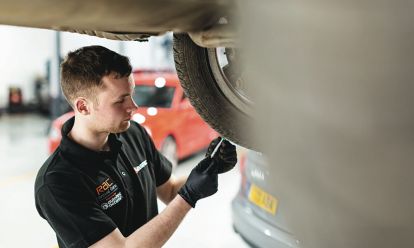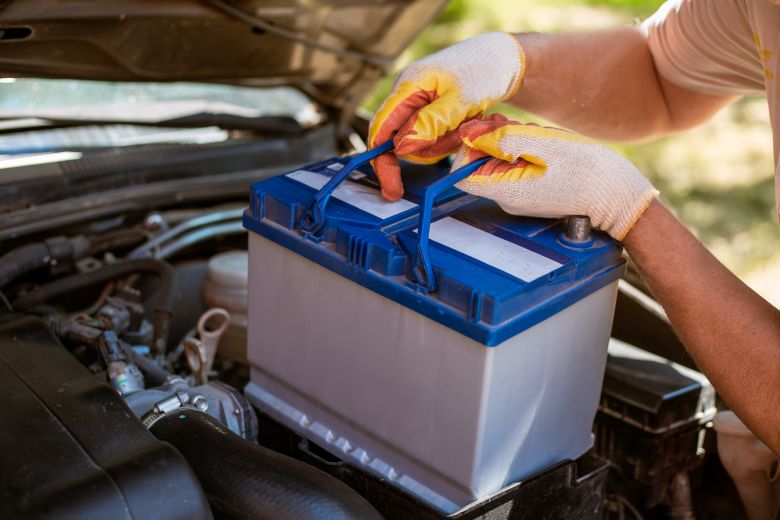Starting problems are often caused by a flat or dead car battery. Thankfully, replacing a faulty battery is a simple task. And you can do it yourself or use the RAC battery fitting service.
If you want to change your car's battery yourself then this step-by-step car maintenance guide will show you what you need to do to get back on the road.
Are you experiencing a car fault, warning, or mechanical problem on your road trip? Find a local mechanic with the RAC.
What is a car battery?
A car battery is a rechargeable energy storage device that provides electrical power to the various components and systems of a vehicle.
It is typically located in the engine compartment and serves as the primary source of electricity for starting the engine and powering the vehicle's electrical systems when the engine is not running – or when the electrical load exceeds the capacity of the alternator.
Car batteries are designed to deliver high amounts of electrical current for short periods, particularly during engine start-up.
They also provide a steady flow of power to the vehicle's electrical system when the engine is running, and they help stabilise the voltage to ensure proper operation of the vehicle’s various components.
It also helps power entertainment systems that are in many modern cars.
Most car batteries are lead-acid batteries, which consist of a plastic case filled with a sulfuric acid electrolyte solution and lead plates. The chemical reaction between the lead plates and the electrolyte produces electrical energy.
Car batteries are typically 12-volt batteries, however, larger vehicles or those with additional electrical demands may have batteries with higher voltages.
All batteries require recharging, as the chemical reaction that produces electricity depletes the amount of energy over a long period of time.
When driving, the vehicle's alternator recharges the battery while the engine is running by converting mechanical energy from the engine into electrical energy.
Regular car maintenance, such as checking the battery's terminals for corrosion and ensuring proper electrical connections, is important for the longevity and performance of a car battery.
Over time, car batteries can degrade and lose their ability to hold a charge, requiring replacement.
Visiting a local garage or contacting a mobile mechanic are good ways to keep your battery in top condition.
Alternatively, you can keep your car battery in its best shape through the annual service.
How long does a car battery last?
Your car battery can last for many years - however, this can vary for many reasons.
Driving conditions, climate, and maintenance can all have an impact.
The quality of the battery itself and how it was originally installed will also make a difference to the lifespan of the battery.
However, on average, a car battery can last between three to five years.
Signs you have car battery issues
There are certain things that can show that it may be time to change your car battery:
These can include the age of the battery, slow engine cranking, dim headlights, electrical issues, a swollen battery casing, or a build-up of corrosion on battery terminals.
How long does an electric car battery last?
When it comes to electric vehicles (EVs), their lifespan is considerable larger than one in a petrol or diesel car.
This is because they are larger, vastly more expensive to make and built to last for longer periods of time.
Drivers of EVs can expect upwards of 10 years or 100,000 miles of use.
However, bear in mind that most EVs also have a traditional 12-volt battery to power the car's on-board equipment, which will have the same lifespan as a petrol or diesel car's battery.
Changing a car battery – a step-by-step guide
How to remove a car battery?
Here, we will tell you how to safely remove a car battery in a few simple steps. However, the first step is to make sure that the engine is off and keys are removed from the engine.
1. Locate the battery:
- Car batteries will be found in the engine compartment. If you are unsure, then your vehicle's owner's manual will have all the information.
2. Disconnect the negative terminal:
- The negative terminal is usually marked with a "-" symbol or labelled "Neg".
- Loosen the nut or bolt that secures the negative cable to the terminal using a spanner or pliers.
- Once the nut or bolt is loose, gently twist and pull the cable away from the terminal. Do not to touch any metal parts with the cable.
3. Disconnect the positive terminal:
- The positive terminal is usually marked with a "+" symbol or labelled "Pos".
- Follow the same steps as above.
4. Remove the battery hold-down bracket:
- Some car batteries have a hold-down bracket. Remove these are they are holding the battery in position.
5. Lift out the battery:
- Carefully lift the battery out of the battery tray, taking care not to tip it or spill any acid.
6. Clean the battery tray:
- Before installing a new battery, clean the battery tray and remove any corrosion or residue. Rinse with clean water and dry thoroughly.
Have you ever experienced a car battery failure?
How to reconnect a car battery
When installing a new battery or reconnecting the old one, reverse the steps from above and connect the positive terminal first, followed by the negative terminal.
To reconnect a car battery, position the new battery in the engine battery tray; re-connect the positive terminal; connect the negative terminal; check the connections; and then start the engine.
Service, repair or MOT?
You can trust the RAC with our local approved garages and NEW mobile mechanics.


How to charge a car battery
There are several ways to recharge your car battery.
- Use a car battery charger
- Use a speed or trickle charger
- If this still isn’t working, then you may need to jump start your car
Electrical issues?
If your car battery keeps dying or electrical systems are acting up, it could be a faulty alternator. Book an RAC Mobile Mechanic today.


How long does it take to charge a car battery?
There are a variety of factors that can impact the amount of time it will take to charge a car battery.
This includes the amount of power it takes to charge, condition of the battery, and how it was originally installed.
However, the average time it takes is from two to eight hours. In some cases, it can take up to a day to charge.
How much does a new car battery cost?
If you are looking to get a new car battery, there are a few important things to consider.
The make, quality and size of the battery all have an impact – as well as how common the battery itself is.
However, the average price starts at around £200 – not including the cost for it to be fitted and tested by a mechanic.
What is car battery recycling?
Car battery recycling is a process of collecting, processing, and reusing or disposing of used car batteries in an environmentally responsible manner.
As they contain various components and chemicals that can be harmful to the environment if not properly handled and recycled, it is important to do this correctly.
The recycling of car batteries involves several steps:
- Collection: Used car batteries are collected from various sources, including automotive service centres, recycling centres, battery retailers, and other designated collection points. It is important to ensure that used batteries are properly stored and transported to prevent leakage or damage.
- Sorting: Once collected, the batteries are sorted based on their type, size, and chemistry. Lead-acid batteries are the most common type found in cars and are distinguished from other battery types.
- Drainage: Before recycling, the batteries undergo a process called drainage to remove the remaining electrolyte or sulfuric acid. The acid can be neutralised and treated for safe disposal or used in other industrial processes.
- Breaking: The drained batteries are broken or crushed to separate the plastic battery casing, lead plates, and other components. This process helps in recycling the individual components more efficiently.
- Recycling: The separated components, including the plastic, lead, and other metals, undergo further recycling processes. The lead can be melted and purified for reuse in the manufacturing of new batteries or other lead-based products. The plastic is typically recycled into new plastic products, while other metals like steel can also be recycled.
- Environmental safeguards: During the recycling process, proper environmental safeguards are followed to minimise the release of hazardous materials. For instance, the acid is neutralised and treated, and emissions are controlled to prevent pollution.
By recycling car batteries, valuable materials such as lead and plastic are recovered and reused, reducing the need for mining, and manufacturing new materials.
Moreover, recycling helps to prevent the improper disposal of hazardous battery components, which can contaminate soil and water sources.
It's important to note that car battery recycling should be carried out by certified recycling facilities who adhere to environmental regulations and safety standards.
Are you looking for a new car battery? The RAC has a wide range available.
A mobile mechanic can carry out a vehicle diagnostic check where they can see the current status on your battery.
Flat or dead batteries are one of the most common causes for a breakdown according to RAC data, so using the RAC’s battery fitting service means you can get back on the road as soon as possible.
High-quality batteries fitted at your home
Skip the garage hassle – RAC Mobile Mechanics come to you!












